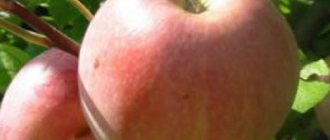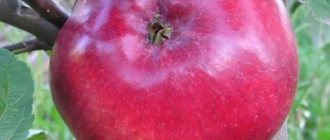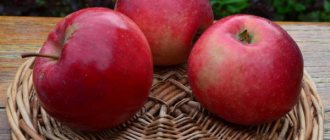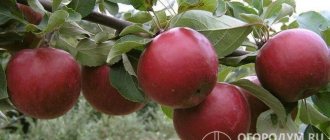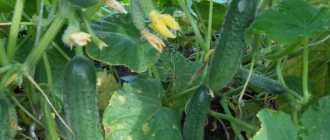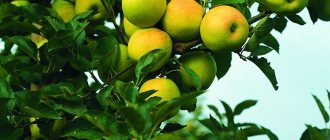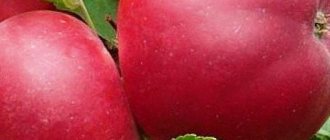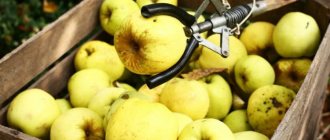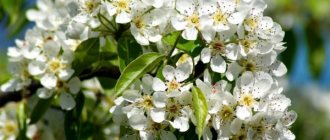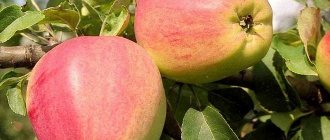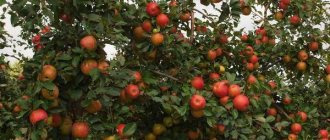- Harvest and storage
In the article we will talk about the “Champion” apple tree, which is included in the category of winter-ripening varieties and is of Czech origin. High productivity, visual attractiveness and excellent taste of the fruit allow “Champion” to remain a leader in the apple orchards of European countries for half a century. Russian amateur fruit growers also highly appreciated the merits of these appetizing and fairly large apples.
The “Champion” apple tree (pictured) is intended for commercial cultivation and industrial production, one of the top ten leaders in the European space
The characteristic characteristics of the variety are given in the table:
| Parameter | Characteristic |
| Culture | Apple tree (Malus domestica Borkh.) |
| Variety | "Champion" |
| Tree height | Medium and short - up to 3-3.5 m |
| Removable (technical) maturity | Second ten days of September – first ten days of October |
| Period of consumption | Winter - stored for about 170 days |
| Precociousness | High (3-4 years after budding on low-growing rootstocks) |
| Type of fruiting | Mixed (on ringlets, fruit twigs and growth tips) |
| Fruit weight | 88-180 g |
| Productivity of an adult tree per season | About 25 kg (average 30.7 t/ha), regular |
| Shape and color | Apples are one-dimensional: round-oval. The skin is thin, but dense and elastic. The color is greenish-yellow with a bright red blush in the form of stripes or blurred over most of the surface. Subcutaneous dots are few in number, white, barely noticeable |
| Professional appearance assessment | 4.5 points (out of 5) |
| Fruit pulp | Creamy, dense, juicy, with a pronounced aroma |
| Tasting assessment (taste qualities) | 4.5-4.7 points (out of 5) – excellent taste, sweet and sour |
| Purpose of fruits | Dessert (universal) |
| Sustainability | Low winter hardiness; weak frost and drought resistance. Immunity to scab, high resistance to powdery mildew; relatively low susceptibility to pests. Susceptibility to bitter pitting and fire blight |
| Registration in the State Register of the Russian Federation | Absent |
History of selection
This variety of apple tree was bred in 1970 at the experimental station in Holovousy (Czech Republic) by breeders who crossed the widely cultivated Golden Delicious in the world and Renet Orange Cox. The resulting “Champion” quickly gained popularity in the industrial fruit market of Western Europe, in particular Poland and Germany, as well as the eastern part of the continent.
In the photo - “Golden Delicious” (left) and “Renet Orange Cox” (right), which served as the initial forms when creating a hybrid variety
Currently, Poland remains the main exporter of “Champion” to European countries.
Despite the abundant and regular yield, high marketable and consumer qualities of the fruit, the variety has not yet received official registration in the State Register of the Russian Federation. Over the past decades, tests of this apple tree have been regularly carried out in regions with warm climates. Due to low winter hardiness, “Champion” demonstrates the best results in the North Caucasus region and Central Russia , in natural zones of forest-steppe and steppe, southern Polesie in Ukraine, and in most regions of Belarus.
In the post-Soviet space, various nurseries and agricultural companies sell planting material for the Champion apple tree.
Many sellers distribute seedlings under all sorts of names, for example “Champion Renault”, “Champion Arno”, “Champion Red”, etc., passing them off as clones of a given variety with improved characteristics - sweeter taste, intense color, large apple size.
It is important to understand that promising advertising descriptions in real life most often disappoint gardeners. Don’t rely on nurseries that are far away and markets where you can buy a “pig in a poke.” The productivity of trees and the quality indicators of fruits, like any other crop, in practice depend on the soil and climatic characteristics of the region, weather factors and competent agricultural technology.
You can learn more about the features of “Champion” and its clones in a video prepared by specialists from one of the Belarusian fruit plant nurseries:
Variety varieties
After the Champion apple tree was bred, scientists decided to improve the variety. As a result of painstaking work, the Champion had several doubles. These include Champion Renault, Arno, Giant, dwarf, semi-dwarf and columnar species.
Apple Giant Champion
The description of the Champion Giant apple tree variety is very similar to the parent one. The tree is medium-sized, forms an ovoid crown. With proper care, the fruit reaches up to 0.5 kg in weight. The variety is resistant to minor drought and has immunity to diseases. The apple tree has a high yield, which is why the Champion Giant variety is grown on an industrial scale.
Apple tree Champion Renault
The Champion Reno variety has good cold resistance and can withstand frosts down to -30°C without shelter. The description of the Champion Reno apple tree shows the advantages of the variety. In mid-September, the densely leafy wide crown forms bright fruits weighing up to 160 g. The pulp is dense, juicy with a dessert taste. The apple tree was bred by crossing the Novakovsky and Reitman species.
Apple tree Champion Arno
Champion Arno is a tall variety. At the beginning of autumn, large bright apples ripen on the tree. The fruits of the Arno variety contain a lot of sugar, making them sweet, but not cloying. Since the tree is not capable of fully pollinating on its own, pollinating varieties must be nearby.
Features of fruiting and specifics of cultivation
The apple tree is low-growing, about 3 meters high (depending on the rootstock). The crown is round, compact, shoot-forming ability is average. Small dimensions allow trees to be grown in compact planting using various types of formation. Moderate pruning is considered the most suitable, involving the removal of competitors of the central conductor and shoots with vertical growth. Additionally, 1/3 of the branches two years old and older are removed. If the procedure is carried out correctly, the apple tree will receive more sunlight, which will have a positive effect on the yield, taste and size of the fruit.
During pruning, part of the fruit buds is also cut off along with the wood. The more buds are removed, the more the load on the tree is reduced. Thus, by changing the pruning force, it is possible to regulate the growth processes and quality of apples.
Moderately developed skeletal branches extend from the trunk at an angle of 50-70°. The bark on the trunk is dark gray. The shoots are light brown with a green tint, medium thickness, curved, slightly pubescent. The leaves are smooth, bright green, in the form of wide ovals with elongated tips.
During the flowering period, the trees are covered with soft pink buds and snow-white flowers
Productivity and pollinators
Since the setting of fruits from pollination by its own pollen in “Champion” is ensured by 32%, it is partially self-fertile. To obtain regular harvests, it is necessary to have apple trees of other varieties nearby, such as “Idared”, “Florina” or “Gala”.
The type of fruiting is mixed: on ringlets, spears and fruit twigs. Trees after budding on weak-growing seed rootstocks begin to bear fruit in the 3rd-4th year . From 7-year-old apple trees you can harvest 15 kg, and at 10 years of age they yield about 25-27 kg. The average yield over four years of testing under optimal conditions of the Nikitsky Botanical Garden was 30 t/ha. Trees grown on superdwarf rootstocks are capable of producing 43.3 t/ha, and on dwarf rootstocks – 27.7 t/ha. At the same time, from the first year of life they need the installation of a stationary support, since early loading with fruits against the backdrop of a fragile root system leads to tilting and breaking of the plant, complicating the formation of the crown.
In the photo - apple tree "Champion" on a dwarf rootstock PA 292
Trees on super-dwarf rootstocks are characterized by increased early fruiting (a fruit bud is formed already in the nursery, fruiting begins in the 2-3rd year), high yield and excellent quality of fruit.
Care
Proper care will help you grow a healthy tree that will delight you with its appearance and good harvests.
Watering
An adult Champion apple tree can tolerate a short-term lack of moisture, but a long period of drought greatly harms the tree. Young trees planted in spring need to be watered more often than older plants. This is necessary for the normal development of the root system. Be sure to include one watering per week in your watering schedule. But be sure to take into account natural precipitation, because stagnation of water in the roots can be harmful.
Young plants should be watered more often than older ones
For an adult Champion, 4-5 moisturizers per season are enough. Each tree needs 20–30 liters of water. Watering is best done in the evening. With age, the number of waterings is reduced, but the amount of liquid is increased, adding 1 bucket of water for each year of life.
To ensure that water is evenly absorbed and moisturizes the soil to the proper depth, it is best to divide the process into 2 steps - morning and evening.
Periods when the apple tree needs moisture:
- before flowering begins;
- after flowering;
- until the first fall of the ovary;
- during the period of fruit filling.
Late water-recharging irrigation is carried out in November. It will help increase the heat capacity of the soil and protect the roots from severe frost. In areas with high groundwater, such irrigation is not carried out.
Watering is carried out in shallow grooves (up to 15 cm deep), laid at a distance of 1 m from the tree trunk. The next groove is laid 0.5 m from the first. This method is easy to water a small garden. Single trees can be watered in ring holes.
Single trees can be watered in holes near the trunk
Care after watering
After watering or rain, the soil in the tree trunk circle needs to be slightly loosened. Thus, you prevent the formation of a crust, which interferes with normal gas exchange in the roots. If the soil is not loosened, it will crack, accelerating the process of moisture loss.
In order not to overburden yourself with caring for the tree trunk circle, it should be mulched. This solves several problems at once: it conserves moisture in the soil, stops the growth of weeds, and prevents the formation of an earthen crust.
Mulching conserves moisture in the soil, stops the growth of weeds, and prevents the formation of an earthen crust
Feeding
They begin to fertilize the Champion apple tree in the 3rd year after planting, taking into account the elements introduced during the preparatory period. The variety is very responsive to alternating organic and mineral fertilizers. Nutrients are introduced by root and foliar methods. Each of them has its own norms and indications.
Root feeding
Organic matter is added in spring and autumn, mainly for digging to a depth of 15–20 cm. Liquid mixtures can also be used, dissolving the substance in water in a ratio of 1:10 (the exception is chicken manure, it should be diluted 1:20). Phosphorus and potassium fertilizers should be added to organic matter.
Table: doses of fertilizers for apple trees
| Apple tree age (years) | Diameter of the trunk circle, m2 | Amount of organic matter per 1 tree in kg | Mineral fertilizers (g substance per 1 apple tree) | ||
| Nitrogen | Phosphorus | Potassium | |||
| 1–2 | 2 | 12–15 | 15 | 15 | 15 |
| 3–4 | 2,5 | 20–25 | 25 | 25 | 25 |
| 5–6 | 3 | 30–40 | 35 | 35 | 35 |
| 7–8 | 3,5 | 40–50 | 50 | 50 | 50 |
| 9–10 | 4 | 50–60 | 70 | 70 | 70 |
| 11 | 4,5 | 80 | 100 | 100 | 100 |
Nitrogen-containing fertilizing is important in the spring and first half of summer. At the end of the summer period, nitrogen is no longer added, so as not to provoke a second wave of shoot formation. Prolonged growth will have a bad effect on the wintering of the apple tree.
Usually organic matter is added for digging
Foliar feeding
This type of nutrition is applied with caution, as an addition to root feeding, which is considered basic.
- After flowering, you can spray the apple tree with Bordeaux mixture, adding 5 g of urea or 3 g of ammonium nitrate to 1 liter of solution. Without Bordeaux mixture, ammonium nitrate can cause leaf burn.
- In the second half of summer, fertilize with a solution of potassium sulfate (20 g) or superphosphate (30–50 g). The specified amount of substance is dissolved in 10 liters of water. Spraying is carried out in the evening or early in the morning. In hot and dry weather, to avoid burning the leaf plate, the solution is made weaker.
Foliar feeding is in addition to the main one - root
Trimming
The main purpose of pruning a seedling is to form a crown. For Champion, this procedure is of no small importance at a young age, since the variety grows intensively before entering the fruiting period. Also, a balanced crown volume ensures the formation of high-quality fruits.
Stages of formation of a 2-year-old seedling:
- To create a trunk area, you should remove all shoots at a level of 50 cm from the soil surface.
- At the first stage, you need to select 3 developed shoots, growing at the same level and at a distance of 15 cm from each other. Mark the central conductor. The branches of the first tier are shortened by 1/3 of the entire length so that their ends are approximately at the same level. The central shoot after pruning should be 15–20 cm higher than the tiered shoots.
- The remaining shoots are cut into a ring.
- In subsequent years, branches of 2 and 3 tiers are laid. Their number can be limited to 2–3 well-developed shoots. They are also cut by 1/3, and competing and weak ones are cut into a ring. The distance between tiers should be at least 50 cm.
- When the tree reaches the desired height, the central conductor is cut and transferred to a side branch.
In the future, carry out thinning and sanitary pruning as necessary. There is no need to show special diligence, since a fruit-bearing apple tree is not prone to strong shoot formation. And excessive removal of branches can cause shock to the plant.
Harvest rationing
Too much developing ovary is not a cause for joy. A champion, especially at a young age, simply cannot handle such a load. The ripened harvest will ultimately not please you with its shape, weight, or taste. Therefore, carefully inspect the tree and rid it of some of the fruit. Those who remain will receive more light and nutrition. As a result, the harvest will exceed all your wildest expectations.
Removing some of the greenfinches will provide the remaining fruits with sufficient light and nutrients.
Preparing for winter
The declared average frost resistance of the Champion apple tree requires certain preparation for the winter period. This especially applies to young apple trees and those grown in regions with a not very warm climate. The preparation period is divided into the following stages:
- Put things in order in the tree trunk circle and clear the crown of diseased and broken branches.
- Whiten the trunks, including the bases of skeletal branches, after first freeing the trunks from old exfoliated bark and covering the wounds with garden varnish.
- Treat the crown against pests and diseases.
- Dig up the tree trunk circle.
- If autumn is dry, carry out moisture-recharging irrigation.
- Be sure to cover the root zone with a thick layer of mulch.
- Be sure to wrap the trunks of the seedlings with any breathable material - fabric, cardboard, newspapers - so that the young wood is not damaged by frost. The trunk of an adult tree also needs to be insulated if it is grown, for example, in the Moscow region.
The Champion apple tree in cold regions must be protected before the arrival of frost
Fruit characteristics
The fruits are one-dimensional: weighing on average 100 g, maximum – 170-180 g. During dry periods, as well as in case of non-compliance with pruning technology and the maximum load of the branches with an abundant harvest, shrinkage of the fruits is observed. The shape of apples is round-oval, smooth, symmetrical. The funnel is shallow, without rust. The skin is thin, but dense and elastic. As it matures, its basic light green color becomes greenish-yellow, covered with a bright red blush - watercolor or in the form of stripes. Subcutaneous dots are few in number, white, and barely noticeable. The pulp is creamy, dense, very juicy, aromatic, with an excellent sour-sweet taste.
Apples are highly marketable - almost the same size, regular shape and bright color
Biochemical studies carried out by specialists from the Nikitsky Botanical Garden and the North Caucasus Zonal Research Institute of Horticulture and Viticulture to determine the nutritional value of fruits revealed that in the conditions of the Crimea and the Krasnodar Territory, the sugar acid index (SAI) of “Champion” reaches 25.8 - a dessert taste with almost optimal balance of sweetness and acidity. The content of soluble solids is 15.8% (at the level of the best winter varieties) - according to experts, this indicator significantly affects the keeping quality of apples and characterizes their suitability for long-term storage. The fruit contains:
| Nutrients and beneficial substances | Quantity per 100 g |
| Vitamin C (ascorbic acid) | 6.7 mg |
| Sahara | 12.9 g (of which monosaccharides – 10.5) |
| Acids | 0.5 g |
| P-active substances (total) | 215.4 mg (including catechins – 70.6) |
Fruits for dessert purposes, intended for fresh consumption and various preparations
Tasting taste ratings – 4.5-4.7 points (out of 5). In reviews, many summer residents describe the taste as “harmonious,” sweet with a slight sourness and fragrant aroma.
Harvest and storage
On young trees, apples are firmly held on the branches and, when ripe, do not spontaneously fall to the ground, unlike mature plantings, the fruits of which are prone to shedding before harvest. Removable (technical) ripeness occurs in the second ten days of September - the first ten days of October. The consumer period begins in November and, with proper storage of fruits (temperature within 0 ... + 5 ℃ and humidity about 85%), lasts 170 days - until May.
To prepare preserves, marmalade, compotes, apples are used at the stage of technical ripeness, immediately after picking. Their dense pulp contains more acid and pectin - such fruits are richer in vitamins, boil less, and gel better.
Apples tolerate transportation well and, with properly organized storage, can last until the end of spring without loss of marketability and taste.
Unfortunately, when laying fruit for the winter, the variety shows its weakest sides. “Champion” is genetically predisposed to bitter pitting, which sharply reduces both the shelf life and the presentation of the fruit. Read about the causes of subcutaneous spotting (bitter pitting) in fruit crops and how to combat it in the article “Feeding apple trees in spring” on our website.
Diseases and pests
No matter how hard scientists try to instill strong immunity in the varieties of apple trees they are creating, diseases still find a loophole. The Champion variety also has weaknesses. But this most likely applies to unkempt trees. Incorrect agricultural technology makes a strong plant defenseless against pests and diseases. To prevent their appearance and development, it is necessary to carry out preventive measures in a timely manner. If trouble has already happened, the right control measures will help quickly cure the apple tree.
Table: diseases and pests most often affecting the Champion apple tree
| Diseases and pests | Symptoms of the lesion | Control measures | Prevention |
| Bacterial burn | The disease first appears on the leaves. Red-brown necrotic spots that appear between the veins spread to the edge of the leaf blade. Then the young shoots begin to wither and bend in the shape of a staff. Flowers and fruits die. The bark also suffers. It becomes soft and begins to crack. | The disease is caused by bacteria and is therefore treated with antibiotics.
|
|
| Bitter pitting | The disease most often affects large-fruited varieties. Small (1.5–3 mm), slightly depressed spots appear on the surface of the fruit. They can be light green or dark red, depending on the color of the variety. Gradually the spots increase in size and darken. The pulp of a diseased fruit becomes loose and bitter. Apples lose their marketable appearance and become unfit for consumption. Most often the disease is caused by a lack of calcium. |
|
|
| Rust | Small red spots appear on the upper side of the leaf. On the lower part they are yellow. Gradually merging, the spots form groups of growths. The leaf loses its ability to photosynthesize. By mid-summer, a sick apple tree may shed its leaves and unripe fruits. |
|
|
| codling moth | During flight, the butterfly lays eggs on the top of an apple tree leaf. After 2–3 weeks, a caterpillar appears, destroys young foliage, makes passages in the pulp of the fruit, getting to the seeds. A damaged apple cannot be stored. |
|
|
Photo gallery: how to recognize diseases and pests
At the initial stage, bacterial burn affects young shoots and leaves, then the bark of the apple tree suffers
Bitterness makes apples unfit for consumption
By interfering with the process of photosynthesis, rust leads to premature leaf fall.
An apple damaged by the codling moth cannot be stored.
Advantages and disadvantages
The “Champion” apple tree was highly praised for its immunity to scab, early fruiting and productivity not only by gardeners, but also by breeders. They actively use this variety as a donor of such valuable qualities as large fruit and the unique dessert taste of apples.
In addition, reviews from summer residents note other advantages:
- compact crown dimensions;
- presentation of the fruit;
- transportability and long-term storage;
- high resistance to powdery mildew.
Manifestations of subcutaneous spotting (bitter pitting) on apples of the “Champion” variety
The disadvantages of the variety include:
- low winter hardiness;
- poor frost and drought resistance;
- partial self-fertility;
- shrinking of fruits when overloaded with crops;
- predisposition to apple shedding in mature trees;
- tendency to subcutaneous spotting of fruits;
- poor resistance to bacterial burn.
Read about the signs of bacterial burn of fruit trees and the treatment of this disease in the article about the Ligol apple tree on our website.
Pros and cons of the variety
The Champion apple tree, like other varieties, has its positive and negative qualities. The advantages include:
- beautiful appearance and aromatic juicy pulp;
- precociousness;
- high and stable yield;
- drought resistance;
- immunity to diseases.
The Champion apple tree has few disadvantages, but they do exist:
- average cold resistance;
- partial self-pollination;
- without proper care, a bacterial burn appears.
Reviews from gardeners
Antonina, 46 years old, Stavropol region
The tree is almost 13 years old. It produces champion sweet harvests regularly; on average we collect about 40 kg per season. True, under the weight of the apples, the branches without supports cracked and broke. Our small tree was saved from death by an umbrella support system. To do this, we dug a tall stake into the ground close to the trunk, to the top of which we tied each branch that needed support with a rope or thick twine. We collect fruit at the end of September. They store well, so first of all we store them for the winter so that we can eat them fresh. They are sweet and fragrant, ideal for making fruit salads. We love them. Apples become especially tasty and beautiful in early November, when they have been lying around for a while. Unfortunately, about three years ago we noticed that fruits that were not collected on time began to spontaneously fall off. I don’t even know what to do, maybe this is due to the characteristics of the variety.
Oleg, 71 years old, Moscow region
Despite its compact size, the Champion apple tree bears fruit annually and abundantly. The apples are not always large; a significant part falls off in August, which is immensely upsetting. The taste, for me personally, is sour. Last, very rainy autumn, almost the entire harvest rotted. When I bought the Champion, I had a lot of hopes, but apparently I was mistaken.
Gennady, 58 years old, Belgorod region
It bears fruit regularly, even a rainy summer is no problem. The impression was that pests and diseases were not afraid of him: neither powdery mildew, nor scab, nor cherry flies that ate our cherries. The tree is not gigantic, it is easy to care for. In the winter, I always cover the trunk to protect it from rodents and freezing. The taste and weight of apples depends on seasonal care. With timely pruning, the fruits are always plump and large. We're shooting in early October. Every autumn we collect more than 30 kg. The harvests are decent and are stored for a long time in a dry basement in boxes, where the apples, packed with straw, almost do not spoil. The fruits are just a sight for sore eyes: beautiful, sweet and juicy! Before the New Year, as a rule, we eat them.
Harvest and storage
In order for apples to be well preserved, ripe fruits must be picked on time. If you delay harvesting, the fruit will quickly lose its taste and be poorly stored.
When harvesting, do not throw apples into the basket, but carefully place them to avoid damage. Sort the fruits, putting spoiled ones aside. You need to collect them during the warm part of the day - after noon. And of course, in dry weather. On the south side, apples ripen earlier. Start removing from the lower branches and gradually work your way up to the top. An apple picked with its stem will last longer.
After picking, Champion apples should sit for about 2 weeks - then they will acquire their true taste
The apple should sit for about 2 weeks, accumulate sugar, and ripen. Only after this the magnificent taste of the fruit will truly reveal itself.
The Champion's transportability is at an average level. The fruits must be well packed. If you are selling apples of this variety, it is advisable to sell the products immediately after picking.
Champion makes wonderful juice, compotes, and jams. Those who like to do some magic in the kitchen can make marshmallows or marmalade. Dried apples are perfectly preserved.
Champion apple juice is very tasty
Productivity
The productivity of the Champion apple tree is high. An adult tree can produce up to 25 kg of sweet and sour fruits. Thanks to its stable and generous harvest, the Champion variety can be grown both in summer cottages and on an industrial scale.
To achieve the desired result, you need to learn how to ration the harvest. Most gardeners are happy when a large number of fruits form on a young tree. This is not a reason for joy, since the young Champion apple tree will not be able to handle such a load. The tree will begin to devote all its energy to ripening the fruits, to the detriment of growing the root system. Therefore, when forming ovaries, it is necessary to rid the tree of part of the harvest. The remaining apples will receive more nutrients and sunlight.
In order for the harvest to last as long as possible, fruits at technical maturity must be harvested in a timely manner. If you miss time, the harvest will lose its taste, presentation and will not retain freshness for a long time.
Harvesting is carried out in dry, warm weather, starting from the lower tier and smoothly moving to the top.
Apples are picked from the branch with the stalk and placed in wooden or plastic boxes. In order for the fruits to reveal their dessert taste and aroma, they must lie in a dark, cool place for about 14 days.
Advantages and disadvantages
The advantages include:
- drought resistance;
- a bountiful harvest;
- good taste;
- bright color;
- strong immunity to powdery mildew and scab.
- poor tolerance to cold;
- needs pollination.
The immune system of the variety is unable to protect the apple tree from bitter pitting and bacterial burn.
Specifications
A description of the characteristics of an apple tree will help a person find out whether this variety is suitable for him to grow or not.
Suitable region and climate
To enjoy the apple harvest, it is recommended to grow trees in regions with climatic characteristics close to their native ones. The Carpathian region is best suited - a steppe or forest-steppe zone. If the Champion grows in a region with a warm climate, it may need shelter for the winter.
Frost resistance
In this regard, the indicator is at an average level. If the frosts are severe, not only the trunk, but also the base branches require shelter. In some cases, complete covering of the tree will be necessary.
Susceptibility to diseases and pests
The champion occasionally suffers from diseases characteristic of fruit trees. A strong immune system often protects against parasitic fungi and bacteria. Most often, the gardener is faced with bitter pitting of fruits.
Features of fruiting
Before the apple tree pleases you with rich and tasty fruits, it goes through several stages of apple formation.
Pollination
Champion is an apple variety that is prone to partial self-pollination. To increase the percentage of ovary formation, Prima, Idared, Lobo and others apple trees are planted next to the tree.
Pollinators should be planted close to Champion.
Beginning of fruiting
After planting, the apple tree is not ready to produce a harvest. The period of formation of green apples falls on the 2nd or 3rd year of the Champion’s life. Sometimes the fruits appear 4-5 years after planting the seedling.
Productivity
In this regard, the Champion adheres to stability and generosity. A five-year-old tree produces at least 20 kg of apples. The fruits are large and identical.
Tasting characteristics of the fruit
Apples taste sweet and sour. They are considered dessert. The pulp is dense, but not very, with a creamy tint.
Reviews of the Champion apple tree
Peskova Elena Grigorievna, 56 years old, Dubna
There is a large apple orchard on the property, which was left to me from my grandmother. I decided to renew old, poorly fruiting apple trees. Neighbors recommended the Champion apple tree. Before purchasing a seedling, I first read the reviews and description of the variety. I bought it, planted it and was not disappointed. A year after planting, the apple tree was all in bloom, but in order not to take away the strength of the young tree, I removed all the flowers. After 3 years, the grown tree pleased with large, tasty and aromatic fruits, which everyone liked. One minus of the variety is that in the Moscow region the young plant needs to be covered for the winter.
Pushkina Olga Efremovna, 49 years old, Nikolaev
I have been growing the Champion apple tree for a long time. I like the variety for its stable and large harvest, which is enough for both conservation and sale. Thanks to its delicious aroma and beautiful appearance, the product does not stay on the shelf for long. I recommend this unpretentious, high-yielding variety to everyone.
Growing in regions
Regardless of the region, apple trees of this variety are recommended to be planted on the south side of the site; it is advisable to take care of protection from the winds.
Attention! Long-term fruiting is affected by swampy soil.
Moscow region
Here, growing the Champion variety is quite successful , but you have to resort to additional measures to be on the safe side: for the winter, the tree trunk must be wrapped in burlap, roofing felt or other insulating materials. Young seedlings and old trees are more susceptible to freezing, so wrapping one- or two-year-old plantings is simply necessary.
Southern Urals
In the Southern Urals, the Champion variety of all subspecies grows without additional means of protection , but the further north you go, the more problematic it is to preserve the tree. Ural gardeners have included in the top ten most popular varieties.
The Champion apple tree is successfully grown in the Southern Urals.
Ukraine
In Ukraine, Champion is also at the peak of popularity. The growing conditions are close in characteristics to the basic breeding conditions due to being at the same latitude with Poland, therefore all clones and subspecies of the variety successfully bear fruit.
Belarus
In Belarus, apples of Polish varieties have taken root, are grown in nurseries and are distributed throughout the surrounding regions. The Champion variety is also an honored leader among amateur and professional gardeners.
Landing
The correct planting of an apple tree determines how well it will take root, whether it will produce a normal harvest and when it will begin to bear fruit. It also affects resistance to certain diseases.
Deadlines
In the conditions of the Moscow region and the Southern Urals, it is better to plant an apple tree in the spring. This variety is sensitive to frost. A young, immature seedling may die in winter. The optimal time for spring planting is the end of April or the first days of May. By this time, the earth is warming up well, and the risk of late frosts is reduced.
If seedlings were purchased in the fall, they can be buried for the winter. Choose an area sheltered from the winds. Dig a ditch 30-50 cm deep and insert seedlings there at an angle of 45⁰. The tops of the twigs point south. They can be covered on top to prevent the buds from freezing in winter.
In warm areas, apple trees can be planted in the fall. It is better to do this in mid-October, a few weeks before the winter cold snaps. To be on the safe side, the seedlings are covered with film.
Preparing the site
A sunny place, protected from northern winds, is considered optimal. It is important to note that this variety is afraid of flooding with groundwater. Their level can be no higher than 2.5 m from the top layer of soil. Also, acidic and overly alkaline soils (high carbonate content) are not suitable for the tree. But the tree grows well on loam and sandy loam.
The site begins to be prepared in the spring, a year or 6 months before planting. Carefully dig up the ground, remove weeds and stones.
After this, you can sow the area with siderite plants, which enrich the soil with nitrogen. Clover, vetch, lupine, peas, mustard, rye, and buckwheat are suitable. When the plants turn green (but before the seeds appear), they are mowed down and buried in the area.
Pit preparation
The pit for planting is prepared in advance
For both autumn and spring planting, the pit is prepared in September. On black soil or sandy soil, its depth and width should be 60-80 cm (40 cm is enough for dwarfs). A hole is dug in clay 80 cm deep and 1 m wide to provide drainage.
The soil from the bottom is taken out to the garden, and the top fertile layer is mixed with fertilizers of the following composition:
- Rotted manure – 30 kg
- Superphosphate – 1 kg
- Potassium chloride – 100 g
- Wood ash – 800 g
- Lime – 300 g
Drive a peg into the bottom of the hole and fill it with the resulting mixture. If the soil is clayey, drainage from coarse sand, expanded clay, crushed brick, small crushed stone or pebbles is placed below. A small ditch is dug around the pit to drain water and covered with sand. At the end, fill everything with a bucket of water to compact the soil.
Selection of seedlings
Two-year-old seedlings are best suited for planting. Unlike annuals, they have 3-5 lateral branches. The stamp must be smooth and without damage. The bark is gray-brown, with a greenish bast visible through it.
Be sure to inspect the root system. The seedling should have 3-4 main roots, with several thin shoots extending from them. To test the elasticity, twist the spine around your finger. If this is easy to do, then his vital functions are normal. The root collar should be of normal thickness, clean, without defects. When transporting the roots, cover them with a rag or hide them in special packaging.
Landing technology
The gap between standard trees in a row is 3.5 m, and between rows - 5 m. For dwarfs and semi-dwarfs, a distance of 2-2.5 m is sufficient, and between rows - 3.5-4.5 m. If the seedlings have been stored for a long time, They are placed in water for a day to revive the roots.
Landing technique:
- Part of the earth is removed from the hole
- Form a small mound from the remains
- Place the tree on a mound and spread the roots around it
- They begin to gradually fill the hole, periodically shaking the seedling (this allows the soil to be evenly distributed around the roots)
- Compact the earth (stronger along the periphery, weaker at the trunk)
- Tie the seedling to a support
- Pour 2 buckets of water in a circle, at a distance of 20-30 cm from the trunk.
- Lay mulch around the trunk
When backfilling, it is necessary to monitor the root collar. It should rise 5-7 cm above the ground.
Fertilization and watering
As the plant grows, and especially in the spring and summer, it is recommended to fertilize the soil. The following chemical elements must be contained in fertilizers:
- calcium;
- magnesium;
- iron;
- zinc;
- potassium;
- nitrogen;
- phosphorus.
Such fertilizers can be purchased at any store that sells gardening products. You can also prepare your own fertilizers, for example, adding rotted cow manure or top fertile soil from coniferous forests to the soil.
When the plant is young and its growth is accelerated in early spring, it is recommended to apply nitrogen-containing fertilizers, which give the plant vigor. In this case, the method of applying fertilizer is to scatter it around the tree trunk within a radius of approximately 1-1.5 meters. After the rains, these fertilizers will begin to penetrate into the surface layers of the soil, which contain many roots of the Champion apple tree; they are the main nutritional organs of the tree.
A month and a half before harvesting, that is, in early August, it is recommended to apply fertilizers rich in phosphorus to the soil, which ensures the ripening of fruits and takes an active part in maintaining the balance between calcium and potassium in the plant. In addition to phosphorus, calcium fertilizers, such as slaked lime, can also be applied at this time. These fertilizers play an important role in pest control.
The Champion apple tree is a fairly drought-resistant variety , however, to increase the quantity and quality of the harvest, it is recommended to additionally water the tree. Watering is carried out based on current climatic conditions, for example, if spring and summer are rainy, then it should be done less often.
Before watering, it is necessary to make an appropriate roller that would surround the tree trunk. The earthen roller can be quite low (10-15 cm) and have a radius of 30-50 cm; its function will be to hold water near the trunk of the apple tree during watering, which ensures slow absorption. The water must be preheated, for example, in a tank in the sun.
It is preferable that the water for irrigation has a temperature close to the soil temperature, since the plant cannot easily tolerate temperature differences, which can lead to various diseases and inhibit the growth of the apple tree.
The process of flowering and fruit appearance
Flowering of the Champion begins approximately in mid-spring for temperate latitudes of our country. In this case, a large number of flowers are formed, which turn the gardens into a real fairy tale. The beauty of blooming apple orchards gives great aesthetic pleasure to the observer.
The flowers of the Champion variety are united in inflorescences and are white, sometimes with pink hues. The flowering itself begins and ends evenly for all trees in the garden. Only 30% of all flowers will result in fruit formation. To increase this number, it is recommended to plant other varieties of apple trees next to Champion, which will increase the efficiency of pollination of each other.
Under favorable conditions, ripe fruits grow to a weight of 250 g , that is, on average, about 100 apples grow on one tree. The fruits themselves are very dense and round in shape, their peel is soft and thin. They try to pick apples from trees 1-2 weeks before they are fully ripe; this time occurs at the end of September - beginning of October. Not fully ripe fruits have a greenish-yellow color with light shades of pink, while ripe fruits have more saturated colors, they become red-orange.
The pulp of Champion apples is characterized by its creamy consistency, shiny, juicy and sweet. Another characteristic of the Champion apple tree is the shelf life of its fruit, so if the apples are placed in a cool place, for example, in a basement or refrigerator, they will not lose their taste and nutritional properties for 5 months.
Agricultural technology
Landing
It is better to choose a place for seedlings on a hill, but protected from the cold northern winds. An area with a low groundwater level is suitable. It is better to plant trees in the spring due to the fear of low temperatures. When planting several trees, it is better to choose a 4x1.5 m scheme. Planting depth will depend on the type of rootstock: dwarf - 40-90 cm; semi-dwarf and vigorous - 60-100 cm. In order for the seedling to take root faster, a nutrient mixture of compost, ash and superphosphate should be placed at the bottom of the hole.
Note! The root collar of the apple tree should be 3-5 cm above the soil surface.
Watering
To get a sufficient amount of moisture around the trees, it is worth making small grooves up to 15 cm deep. You need to water until the tree “gets drunk.” Only the evening time is suitable for watering; the moisture will be absorbed overnight, preventing burns of young shoots.
Trees need to be watered weekly. The amount of moisture required depends on the age of the apple tree: the older it is, the more water is needed. One-year-old seedlings need 20-30 liters of water, two-year-old seedlings need up to 50 liters, and older than 3 years old seedlings need 100 liters. After each watering, it is necessary to loosen the soil.
Important! Watering trees should be stopped no later than 2 weeks before harvest.
Top dressing
In spring, the apple tree can be fed with fertilizers containing nitrogen (saltpeter, ammonium sulfate, urea, chicken droppings). But in the summer it is worth switching to fertilizers containing phosphorus and potassium.
One of the competitive features of this variety is the beautiful color of the fruit. Therefore, in addition to providing light conditions to all levels of branches, it is necessary to constantly ration the fruits. It is also recommended to spray the leaves 2-3 times with phosphorus-containing solutions about a month and a half before harvest.
Trimming
To obtain a rich harvest, the tree is pruned in March, before the sap begins to flow. This will increase fruiting, reduce the risk of powdery mildew, ensure sun exposure to the fruit, and, accordingly, have a better effect on their color.
Pruning in the first two years is carried out in order to form the crown. After fruiting begins, it stimulates productivity and germination. To do this, branches without buds and with weak buds are safely removed. It is also necessary to remove old branches (over 3 years old) in order to rejuvenate the branches.
Important! You should not cut the branches completely to the ring; you need to give the tree the opportunity to subsequently throw out new, stronger shoots.
